May 25, 2005
Two days in Beijing
Though I have been to Beijing many times in the past, I still am in literal 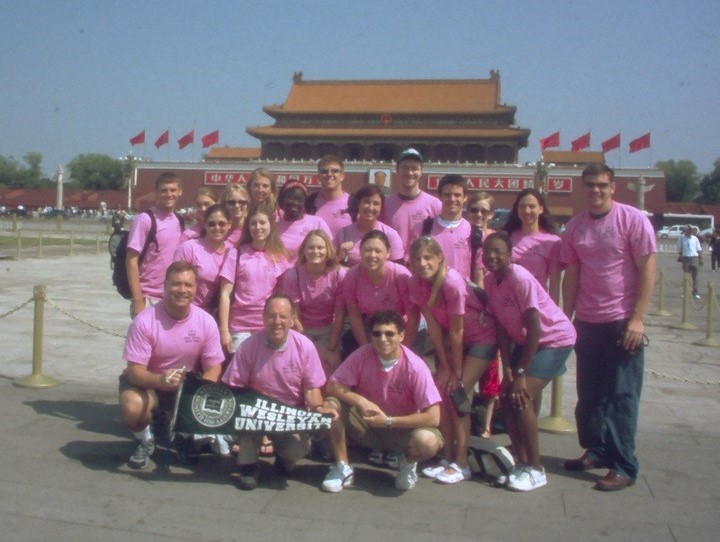 awe when I’m in what the Chinese think of the center of the Universe.
awe when I’m in what the Chinese think of the center of the Universe.
We arrived, as I said, after a lengthy trial from Macau, just as the explorers of old did. We got to the old terminal (now used for domestic flights) and were taken to the Workers’ Stadium hotel, which is actually housed in a soccer stadium built for the 1990 Asian games. It also serves as a hostel, which is to say that the facilities are nice, but the amenities are lacking. For example, they neither sell stamps nor take cards, and it’s a good thing I speak the rare Fred dialect, because their English is worse than my Chinese. I was a little disappointed that we are far from the center of the city, but this is a new neighborhood to explore!
Our days are filled with one spectacular sight after another, and I can only 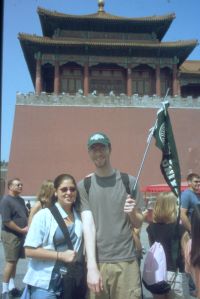 imagine how it must have been from people coming from less developed countries–say Bloomington Illinois–when they arrived in the Middle Kingdom. Walking through the Forbidden City (as we did yesterday), literally in awe of its 9999 rooms, I still wonder why the British ambassador refused to kowtow to the emperor, which was one of the Chinese demands on the West. When the British refused, one result was the Opium War, the beginning of an anomaly in Chinese history–a century and a half when the barbarians ruled China. From the Forbidden City, home of two dynasties and 24 emperors (until 1911) we went to the Temple of Heaven.
imagine how it must have been from people coming from less developed countries–say Bloomington Illinois–when they arrived in the Middle Kingdom. Walking through the Forbidden City (as we did yesterday), literally in awe of its 9999 rooms, I still wonder why the British ambassador refused to kowtow to the emperor, which was one of the Chinese demands on the West. When the British refused, one result was the Opium War, the beginning of an anomaly in Chinese history–a century and a half when the barbarians ruled China. From the Forbidden City, home of two dynasties and 24 emperors (until 1911) we went to the Temple of Heaven.
In an agricultural society, harvest is critical, and one of the main functions of the emperor was to pray for good harvests. What we found, however, was that much of Beijing is in the process of being prepared for the coming Olympic Games. When I was here in the 90s, China tried and failed to secure the Olympics. Those of us who had been here knew why–the toilets and infrastructure could not have accommodated the mobs. The great leap forward (actually that refers to a Mao fiasco) in the last ten years have really made a difference, but some of the historical structures, as we discovered, were closed.
In the evening, we went to the Beijing opera, which is a combination of singing and acrobatics and kind of neat (if it’s opera for foreigners; otherwise it’s more like what some of you think Wagner is like). It was opera for foreigners, so we enjoyed it.
This morning, I went outside the stadium, ran, and did yoga, which drew a great deal of applause from the locals, who do tai chi and a lot of stretching, at least the old people do (my age).
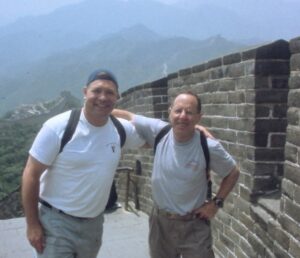 That began another day of taking students to things they had only seen on TV and dreamed about doing. We went to the Great Wall, which stretches over 3000 miles from central Asia to the Gulf of Petchili, and passes about 50 miles north of Beijing. I remember the first time I went on a two-lane road–weaving among the horse carts. Today it is a superhighway.
That began another day of taking students to things they had only seen on TV and dreamed about doing. We went to the Great Wall, which stretches over 3000 miles from central Asia to the Gulf of Petchili, and passes about 50 miles north of Beijing. I remember the first time I went on a two-lane road–weaving among the horse carts. Today it is a superhighway.
There is now some choice of Great Wall sights, since they have rebuilt great 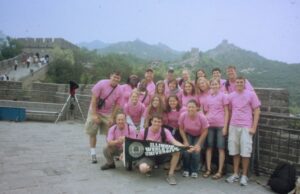 stretches of it. I took the class to Badaling, which has the most people and the pushiest vendors–that is part of the experience. We climbed over 680 feet, and I realized that the first emperor and his successors had been wise in building the wall because, while it never kept the barbarians out (or the Chinese in), it is a great tourist attraction!
stretches of it. I took the class to Badaling, which has the most people and the pushiest vendors–that is part of the experience. We climbed over 680 feet, and I realized that the first emperor and his successors had been wise in building the wall because, while it never kept the barbarians out (or the Chinese in), it is a great tourist attraction!
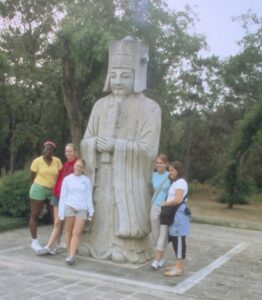 The other highlight in that area is the tombs of the Ming emperors. You have seen pictures of the stone animals that guard the valley; if you haven’t I may show you mine, and some of you will get postcards of them.
The other highlight in that area is the tombs of the Ming emperors. You have seen pictures of the stone animals that guard the valley; if you haven’t I may show you mine, and some of you will get postcards of them.
We had a free night, so some of the students went to Pizza Hut, while over half elected to go to a Xinjiang restaurant that serves central Asian food and has a wonderful floorshow–something they could not find in Bloomington.
Tomorrow we have another day of being taken to wonderful sites, but I’ll save that until we visit them!